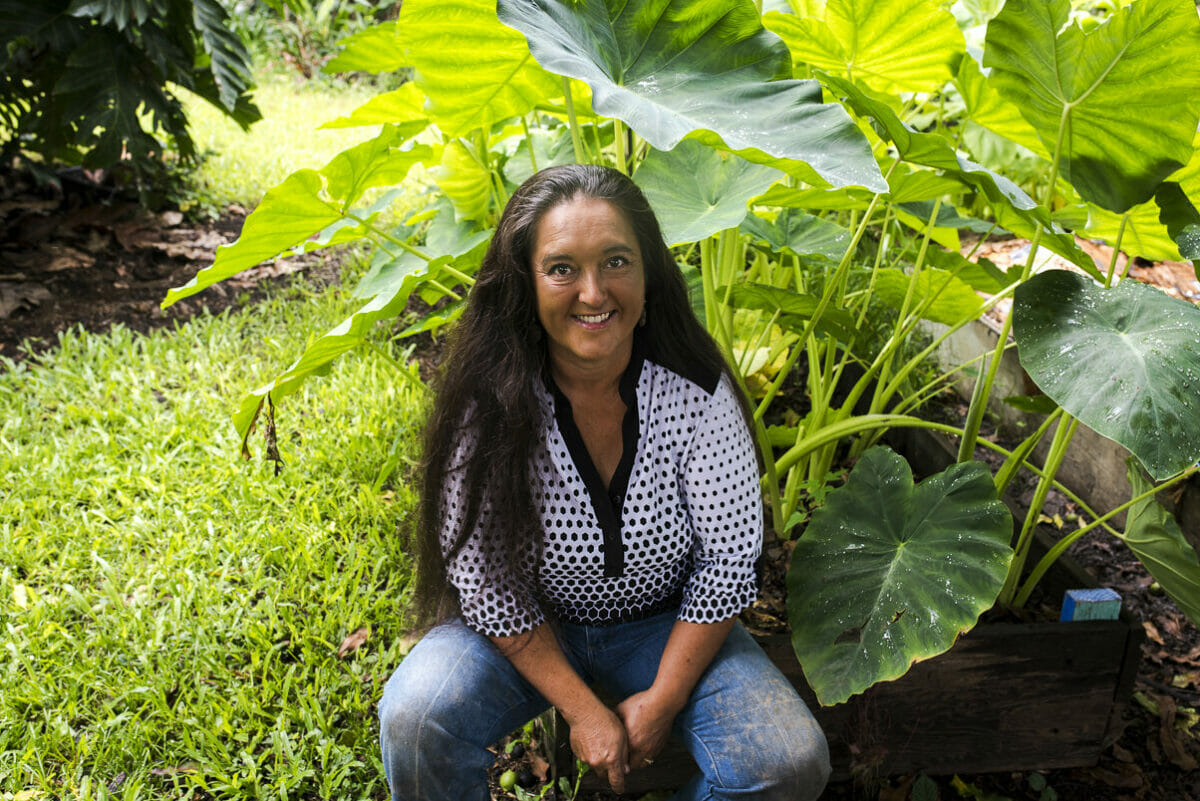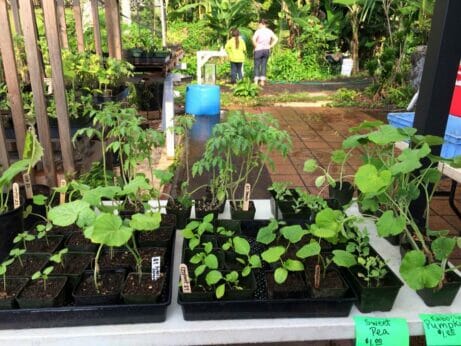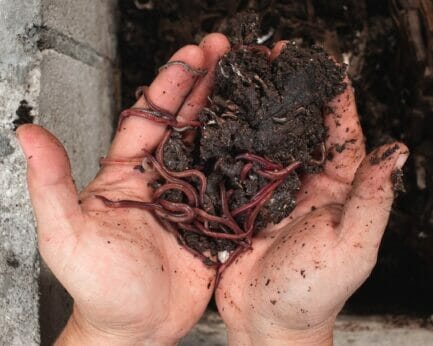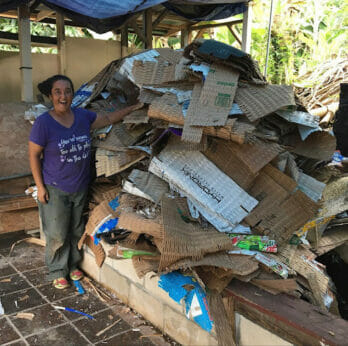In South Kona, Emiko Chantal Chung wants to create a relationship-rich ecosystem to feed local families and transform waste management, starting with her beloved worms.

In 2007, Emiko Chantal Chung was asked to help plan a multi-million-dollar civic center on land that was once a botanical garden she had wandered through as a child. The land had since turned into an illegal dumping ground.
At the time, she was working for a Hawaiian culture-based preschool as a family advocate and, while the civic center was supposed to be for the community, Chung felt an intuitive nudge that the land was meant for something else.
A year later, the recession hit and investors pulled out of the project. It was then that she and two of her friends, Hala Medeiros and Lovey Simmons, realized they wanted to build more for their children and opt into a decolonized system of living that favors people over profit.
“So we started off with food. How can everybody be fed?” says Chung.
A vision of community
Over the next four years, a grassroots effort of volunteers, neighbors and equipment donors helped clean up the land to prepare it for what was next: Ma’ona Community Garden, Hawai’i Island’s first community garden. Founded by Chung, Medeiros and Simmons, the garden grew out of an effort to create more community access to nutritious, sustainably grown food.
Now, more than a decade later, the 5.4 acres of land have been transformed to create a multifaceted food system designed to meet the needs of local families and empower food sovereignty, particularly for the Native Hawaiian and other Pacific Islander communities most in need.
Currently, Hawai’i imports 85-90 percent of its food and, according to a report tracking the incidence of financial hardship in Hawai‘i, 44 percent of people cannot afford basic necessities. In 2015, in Hawai’i County alone, that number was 55 percent, with Native Hawaiians and other Pacific Islanders disproportionately represented.
RELATED: The Struggle to Contain, and Eat, the Invasive Deer Taking over Hawaii
Recently designated a USDA People’s Garden, Ma’ona (which in Hawaiian means “full or satisfied after eating”) produces an abundance of fruits and vegetables, some of which are grown in several demonstration gardens, along with individual and family plots that provide land access to local residents to grow what they want.
Ma’ona also grows the traditional staple crop of ulu (breadfruit) in partnership with Māla Kalu’ulu, an organization restoring the ancient breadfruit agroforests that existed prior to colonization. Taro, another traditional food staple, is also grown on the property, and there is also an experimental food forest and fruit germplasm repository maintained with another partner, Hawai’i Tropical Fruit Growers, to store and study fruit seeds and genetic material. The garden also features a 3,500-gallon aquaponics operation that grows watercress and ong choi, as well as traditionally farmed fish such as awa and ‘ama’ama.

Vegetable starts. (Photo courtesy of Ma’ona Community Garden)
The garden’s focus on community includes free community workshops on how to grow food and monthly food plant giveaways. There are also work-shares available for those needing to fulfill USDA work requirements to receive Supplemental Nutrition Assistance Program (SNAP) benefits.
“This way, some of them can bring their kids, so they don’t have to worry about paying for childcare,” says Chung.
A wormy waste management system
In 2016, Ma’ona started its Community Composting Project, which has evolved into the island’s most impressive community waste management operation.
The state of Hawai’i County’s waste infrastructure is dire, with one of only two landfills permanently closed. Not long after China stopped accepting plastics from other countries, Hawai’i County’s private contractor Business Services Hawai’i said it could no longer afford to process most types of plastic waste, so the county ceased accepting a majority of it for recycling.
When you enter Ma’ona, one of the first things you see are stacks upon stacks of cardboard, bags stuffed with shredded paper and a lot of plastic waste and glass bottles, all surrounding more than a dozen forty-by-four-foot vermiculture bins.
Inspired by models made in India, the bins are used for thermophilic composting, which encourages microbial activity to generate heat levels that kill off human pathogens and other bacteria. They hold thousands of worms that process food waste into what Chung says is some of the finest compost on the island.

Chung uses perionyx excavatus, or “Indian Blue Worms,” to process food and paper waste into compost. (Photo courtesy of Ma’ona Community Garden)
Chung partners with Hawaii’s Ulu Cooperative, a co-op made up of more than 80 local farmers, to take care of their food waste. In the early days of their partnership, before enlisting other composters, she was composting a thousand pounds of food waste a week.
To expedite the breakdown process, Chung helps redirect other waste streams from paper and cardboard; the latter usually gets shipped to Asia or ends up in the only landfill available on island. The cardboard takes 4 to 6 months to break down in the bins. It not only helps sequester carbon in the soil, but it supplies energy to the microbes as it decomposes, improving soil quality and structure. According to Chung, the worms love it.
RELATED: Mending Hawaii’s Lack of Food Security Through Breadfruit
Chung used to scavenge for the cardboard all over Kona and shred it herself, but in the last two years, she has been partnering with the mobile shredding company Circlepack with machines to do it for her. The garden now hosts a 24/7 drop-off for communities and businesses for monthly community cardboard shreds, which typically yield up to a thousand tons of cardboard that can be put to productive use, either at Ma’ona or dispersed among other farmers.
Fifteen of the worm bins produce compost she uses for the rest of her operation, and the rest is donated to schools and organizations and distributed to farmers and gardeners, many of whom are sitting on a long wait list to receive it.
“This place runs on relationships,” says Chung.”It’s the people and their relationships in the community that make this happen.”
She began building a new worm bin in February that will incorporate glass and plastic bottles into the eco-bricks that make up the bin’s concrete structure. Prior to being entombed in the concrete blocks, the eco-bricks will have 1.5 to 2 lbs of non-recyclable plastic pushed inside, which will amount to about 300 lbs of plastic encased in 200 bricks.

Chung shows off a pile of cardboard waiting to be composted. (Photo courtesy of Ma’ona Community Garden)
“I’m not a big waste management company or a multinational corporation who wants to run those sales. I’m in a direct relationship with farmers and producers,” says Chung, adding that she doesn’t want to service people outside of a 15-mile radius.
Chung says she would like to see her model replicated. “My greatest joy would be to see twenty to thirty of these [operations] all around the island, producing for their farmers from their farmers; servicing every food hub, every food processor.”
As for what’s next, she wants to build a certified kitchen, which is necessary to process food and legally sell it. Chung has also been thinking about how farmers like herself can best support each other’s well-being and mental health—a struggle in the industry that has become nationally recognized as a public health crisis over the last few years.
The solution, she thinks, comes down to what Ma’ona is founded on: relationships.
“What I want to see, seven generations from now, is a secure, well-fed, relationship-rich ecosystem of people that are prosperous, where the land is fruitful and well taken care of and where everyone is taking care of each other.”
Sounds good. But the figures of people not being able to afford basic necessities seem high. Anything that helps people eat cannot hurt.
Check out David Blume. He is an advocate for the production of ethanol fuel, especially at local, small and medium scales through permaculture farming-
This site is very educative